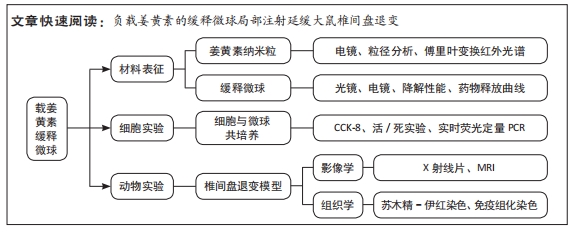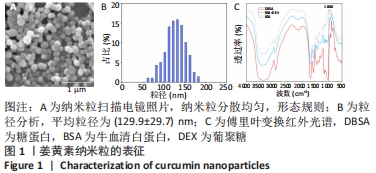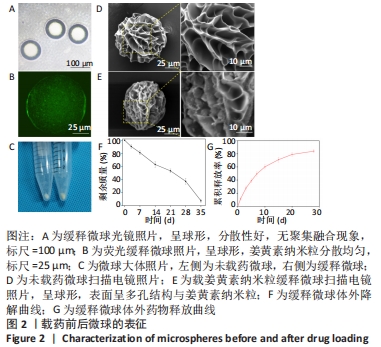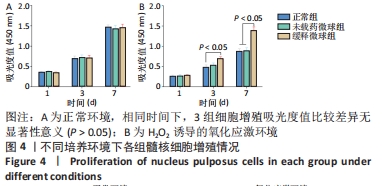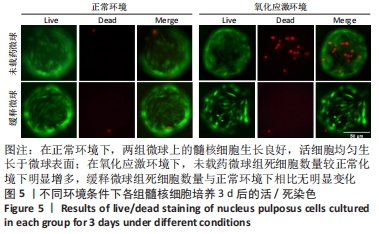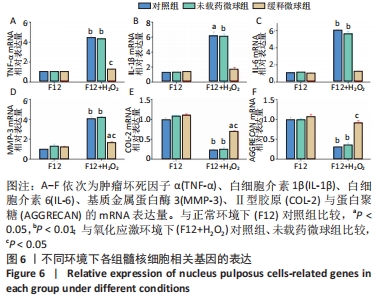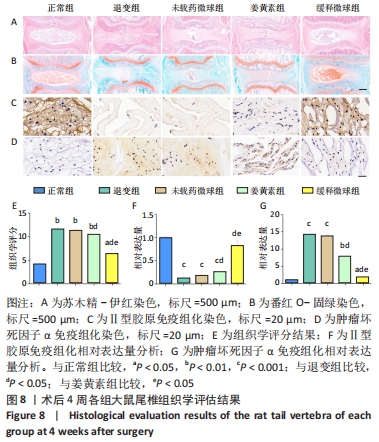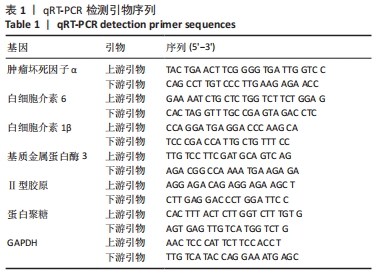[1] VOS T, ABAJOBIR AA, ABBAFATI C, et al. Global, regional, and national incidence, prevalence, and years lived with disability for 328 diseases and injuries for 195 countries, 1990-2016: a systematic analysis for the Global Burden of Disease Study 2016. Lancet. 2017;390(10100):1211-1259.
[2] ROBERTS S, EVANS H, TRIVEDI J, et al. Histology and pathology of the human intervertebral disc. J Bone Joint Surg Am. 2006;88A:10-14.
[3] FRAPIN L, CLOUET J, DELPLACE V, et al. Lessons learned from intervertebral disc pathophysiology to guide rational design of sequential delivery systems for therapeutic biological factors. Adv Drug Deliv Rev. 2019;149:49-71.
[4] RISBUD MV, SHAPIRO IM. Role of cytokines in intervertebral disc degeneration: pain and disc content. Nat Rev Rheumatol. 2014;10(1):44-56.
[5] GRUBER HE, HANLEY EN. Biologic strategies for the therapy of intervertebral disc degeneration. Expert Opin Biol Ther. 2003;3(8):1209-1214.
[6] GOEL A, KUNNUMAKKARA AB, AGGARWAL BB. Curcumin as “Curecumin”: From kitchen to clinic. Biochem Pharmacol. 2008;75(4):787-809.
[7] MA T, GUO C J, ZHAO X, et al. The effect of Curcumin on NF-kappa B expression in rat with lumbar intervertebral disc degeneration. Eur Rev Med Pharmacol Sci. 2015;19(7):1305-1314.
[8] Barzegar A, Moosavi-Movahedi AA. Intracellular ROS Protection Efficiency and Free Radical-Scavenging Activity of Curcumin. Plos One. 2011;6(10):e26012.
[9] ANAND P, KUNNUMAKKARA AB, NEWMAN RA, et al. Bioavailability of curcumin: Problems and promises. Mol Pharm. 2007;4(6):807-818.
[10] TABANELLI R, BROGI S, CALDERONE V. Improving Curcumin Bioavailability: Current Strategies and Future Perspectives. Pharmaceutics. 2021;13(10):1715.
[11] AN FF, ZHANG XH. Strategies for Preparing Albumin-based Nanoparticles for Multifunctional Bioimaging and Drug Delivery. Theranostics. 2017;7(15):3667-3689.
[12] SADEGHI R, MOOSAVI-MOVAHEDI AA, EMAM-JOMEH Z, et al. The effect of different desolvating agents on BSA nanoparticle properties and encapsulation of curcumin. J Nanopart Res. 2014;16(9):2565.
[13] FAN Y, YI J, ZHANG Y, et al. Fabrication of curcumin-loaded bovine serum albumin (BSA)-dextran nanoparticles and the cellular antioxidant activity. Food Chem. 2018;239:1210-1218.
[14] YUE K, TRUJILLO-DE SANTIAGO G, MOISES ALVAREZ M, et al. Synthesis, properties, and biomedical applications of gelatin methacryloyl (GelMA) hydrogels. Biomaterials. 2015;73:254-271.
[15] SHI K, HUANG Y, HUANG L, et al. Research progress of hydrogel used for regeneration of nucleus pulposus in intervertebral disc degeneration. Zhongguo Xiu Fu Chong Jian Wai Ke Za Zhi. 2020;34(3):275-284.
[16] DE GEEST BG, URBANSKI JP, THORSEN T, et al. Synthesis of monodisperse biodegradable microgels in microfluidic devices. Langmuir. 2005;21(23):10275-10279.
[17] YANG J, ZHU Y, WANG F, et al. Microfluidic liposomes-anchored microgels as extended delivery platform for treatment of osteoarthritis. Chem Eng J. 2020;400:126004.
[18] BIAN J, CAI F, CHEN H, et al. Modulation of Local Overactive Inflammation via Injectable Hydrogel Microspheres. Nano Lett. 2021;21(6): 2690-2698.
[19] KOTHA RR, LUTHRIA DL. Curcumin: Biological, Pharmaceutical, Nutraceutical, and Analytical Aspects. Molecules. 2019;24(16):2930.
[20] ZAKERIKHOOB M, ABBASI S, YOUSEFI G, et al. Curcumin-incorporated crosslinked sodium alginate-g-poly (N-isopropyl acrylamide) thermo-responsive hydrogel as an in-situ forming injectable dressing for wound healing: In vitro characterization and in vivo evaluation. Carbohydr Polym. 2021;271:118434.
[21] 王厚磊,卢伟,李德芳,等.大鼠椎间盘髓核细胞体外凋亡模型的建立[J].中国实验动物学报,2015(6):607-611.
[22] CALIARI SR, BURDICK JA. A practical guide to hydrogels for cell culture. Nat Methods. 2016;13(5):405-414.
[23] TAYLOR SC, NADEAU K, ABBASI M, et al. The Ultimate qPCR Experiment: Producing Publication Quality, Reproducible Data the First Time. Trends Biotechnol. 2019;37(7):761-774.
[24] ISSY AC, CASTANIA V, CASTANIA M, et al. Experimental model of intervertebral disc degeneration by needle puncture in Wistar rats. Braz J Med Biol Res. 2013;46(3):235-244.
[25] XIA K, ZHU J, HUA J, et al. Intradiscal Injection of Induced Pluripotent Stem Cell-Derived Nucleus Pulposus-Like Cell-Seeded Polymeric Microspheres Promotes Rat Disc Regeneration. Stem Cells Int. 2019; 2019:6806540.
[26] MASUDA K, AOTA Y, MUEHLEMAN C, et al. A novel rabbit model of mild, reproducible disc degeneration by an anulus needle puncture: Correlation between the degree of disc injury and radiological and histological appearances of disc degeneration. Spine. 2005;30(1):5-14.
[27] BAI JY, ZHANG YZ, FAN Q, et al. Reactive Oxygen Species-Scavenging Scaffold with Rapamycin for Treatment of Intervertebral Disk Degeneration. Adv Healthc Mater. 2020;9(3):e1901186.
[28] XU H, SUN M, WANG C, et al. GDF5-GelMA injectable microspheres laden with adipose-derived stem cells for disc degeneration repair. Biofabrication. 2020;10.1088/1758-5090/abc4d3.
[29] XU Y, GU Y, CAI F, et al. Metabolism Balance Regulation via Antagonist-Functionalized Injectable Microsphere for Nucleus Pulposus Regeneration. Adv Funct. Mater. 2020;30(52):2006333.
[30] ROHIWAL SS, ELLEDEROVA Z, TIWARI AP, et al. Self-assembly of bovine serum albumin (BSA)-dextran bio-nanoconjugate: structural, antioxidant and in vitro wound healing studies. Rsc Adv. 2021;11(8): 4308-4317.
[31] KLAWITTER M, QUERO L, KLASEN J, et al. Curcuma DMSO extracts and curcumin exhibit an anti-inflammatory and anti-catabolic effect on human intervertebral disc cells, possibly by influencing TLR2 expression and JNK activity. J Inflamm (Lond). 2012;9(1):29.
[32] MAHESHWARI RK, SINGH AK, GADDIPATI J, et al. Multiple biological activities of curcumin: A short review. Life Sci. 2006;78(18):2081-2087.
[33] LAO CD, RUFFIN MTT, NORMOLLE D, et al. Dose escalation of a curcuminoid formulation. BMC Complement Altern Med. 2006;6:10.
[34] 任爽,董文霞,刘锦芳,等.食品运载体系包埋姜黄素的研究进展[J].食品科学,2021,42(9):264-274.
[35] EDWARDS RL, LUIS PB, VARUZZA PV, et al. The anti-inflammatory activity of curcumin is mediated by its oxidative metabolites. J Biol Chem. 2017;292(52):21243-21252.
[36] MARTINS C, SOUSA F, ARAUJO F, et al. Functionalizing PLGA and PLGA Derivatives for Drug Delivery and Tissue Regeneration Applications. Adv Healthc Mater. 2018;7(1):10.1002.
[37] DALY AC, RILEY L, SEGURA T, et al. Hydrogel microparticles for biomedical applications. Nat Rev Mater. 2020;5(1):20-43.
[38] 马晟,贾育松,孙旗.体内腰椎间盘退变动物模型的研究与进展[J].中国组织工程研究,2017,21(11):1790-1797.
[39] ZHOU HY, BEEVERS CS, HUANG SL. The Targets of Curcumin. Curr Drug Targets. 2011;12(3):332-347.
[40] PENG Y, AO M, DONG B, et al. Anti-Inflammatory Effects of Curcumin in the Inflammatory Diseases: Status, Limitations and Countermeasures. Drug Des Devel Ther. 2021;15:4503-4525.
[41] WANG C, YU XH, YAN YG, et al. Tumor necrosis factor-alpha: a key contributor to intervertebral disc degeneration. Acta Biochim Biophys Sin (Shanghai). 2017;49(1):1-13.
[42] LIANG H, YANG XJ, LIU C, et al. Effect of NF-kB signaling pathway on the expression of MIF, TNF-alpha, IL-6 in the regulation of intervertebral disc degeneration. J Musculoskelet Neuronal Interact. 2018;18(4):551-556.
[43] WANG YJ, CHE MX, XIN JG, et al. The role of IL-1 beta and TNF-alpha in intervertebral disc degeneration. Biomed Pharmacother. 2020;131:110660.
[44] 白荣飞,张震,林一峰,等.三种方法建立大鼠腰椎间盘退变模型[J].中国组织工程研究,2018,22(16):2514-2519.
|
